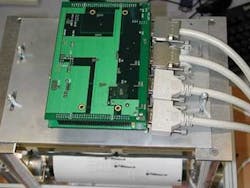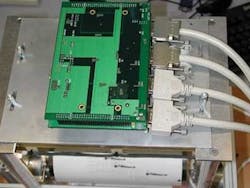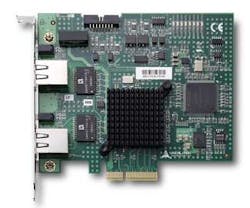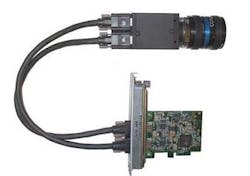Extendable Standards
Andrew Wilson, Editor
With the number of camera-to-frame grabber interfaces now available, one might believe that each individual interface offered specific benefits to fit the needs of individual image-processing and machine-vision applications. While this is true to a certain extent, new developments in integrating the disparate features of these interfaces and extending their capabilities is leading to a blurring of the advantages offered by a single camera-to-frame grabber interface.
Today, numerous vendors offer Camera Link, Gigabit Ethernet, FireWire, USB, analog, and stand-alone products that tie cameras to computers. Camera Link, the first point-to-point interface standardized by the Automated Imaging Association, is still the fastest, most deterministic of these, offering a maximum data transfer rate of 680 Mbytes/s in the Full configuration.
Endorsed by most frame grabber and camera vendors, this interface does have its limitations, most notably the lack of an elegant upgrade to support ultrahigh-speed cameras, the limited 10-m distance that can be achieved between camera and computer, and the lack of any data re-transmission or checking protocol. To overcome these limitations, several companies have devised clever schemes to extend the life of the standard.
High-speed interfaces
To support their high-speed cameras, for example, both the A504k from Basler Vision Technologies and the MC1310 and MC1311 from Mikrotron re-assign the Spare, Data-valid, and Frame-valid control signals of the interface to allow the transport of up to 80 bits of data per pixel clock. Support of this unofficial standard has also been endorsed by a number of Camera Link frame grabber vendors.
However, extending the interface further to accommodate cameras based on larger, faster imagers will be difficult as evidenced by Awaiba at last year’s VISION show in Stuttgart. To support its latest 16k × 1 imager, for example, the company showed a camera demonstration that included a sensor evaluation board based on two Camera Link Full data interfaces running in parallel.
Because the data rate of the camera is 1.6 Gbytes/s, and the maximum data rate of the Camera Link interface is 680 Mbytes/s, two Full Camera Link microEnable IV-Full Camera Link frame grabbers from Silicon Software were required to transfer image data to the host PC (see “CMOS sensors target multiple applications,” p. 19, this issue). While effective, the interface was, in many respects, rather inelegant and costly, highlighting the need for a new high-speed camera interface (see Fig. 1).
Of course, other options do exist. BitFlow, for example, offers a dual slot configuration for its KBN-PCE-CL4-F frame grabber that can be used to interface up to two Full Camera Link interfaces at speeds of up to 85 MHz. With a price of approximately $2500, the board is configured as a single PCI Express interface that offers a single Full Camera Link interface and an auxiliary adapter board that supports the second Full Camera Link interface.
Many high-speed camera vendors will be struggling with the same issue over the next few years, and others will endeavoring to maintain the large base of installed Camera Link products. While it is unlikely that any error-correction protocol will ever be encompassed into the existing standard, cable vendors such as Components Express Inc. (CEI) are looking to extend the 10-m camera-to-computer distance currently limiting the standard in many applications.
By integrating pre-emphasis into the Camera Link cable, CEI now offers Base Camera Link cables running at 85 MHz to extend as far as 25 m and Full Camera Link cables also running at 85 MHz to extend as far as 17 m with no signal degradation (see “Pre-emphasis increases Camera Link cable distances,” p. 17, this issue).
Increased distance
Of course, there are other methods to increase the distance between Camera Link cameras and frame grabbers. One of the most popular of these is the use of stand-alone Camera Link to fiberoptic extenders. Just as Camera Link camera vendors offer different clock speeds and Camera Link modes, fiberoptic extender vendors are meeting these needs with a variety of add-on peripherals that range from add-on camera extenders to stand-alone modules, all with different specifications (see“Reaching Further,”Vision Systems Design, October 2008).
To date, few camera vendors have incorporated any type of fiber interface into their cameras. However, this is about to change, with camera vendors teaming with third-party fiberoptic extender vendors or developing camera products that incorporate fiberoptic interfaces. Last month, for example, Quest Innovations and Phrontier Technologies announced a fiberoptic adapter board, the Q-Series, designed by Phrontier for integration with Quest Innovations’ cameras.
The Q-series provide 300 Mbytes image data throughput directly output from the camera into optical fiber cables, eliminating the link distance limitation with copper cables. The optical interface on the back of the Quest camera connects with Phrontier’s PHIRE receiver on the frame grabber side to provide standard Camera Link interface and optical-to-electrical conversion (see related story “Under the Skin,” pp. 35–38, this issue).
Other vendors are also realizing the benefits of adding fiber interfaces to their Camera Link cameras. At VISION 2008, for example, Smart Systems showed the first version of its fiber interface embedded into its xposure 10G camera, based on the company’s 4000 linescan camera that incorporates a 2352 × 1728-pixel array sensor from Aptina Imaging and couples the Camera Link Medium output to a high-speed 10G Ethernet fiberoptic interface.
Gigabit Ethernet too
While the Camera Link interface—and its limitations—have gained much publicity over the past few years, other albeit slower interfaces have taken hold for applications where data transfer is less critical. Like the Camera Link interface, the GigE Vision interface standardized by the AIA has its limitations. These include the types of GigE frame grabbers and software drivers that must be used to gain maximum performance from the standard, the lack of an embedded deterministic camera triggering standard, and the limited 1000-Mbit/s data transfer rate.
Here, too, many manufacturers offer solutions that can to some extent ameliorate these limitations. One of the greatest misconceptions regarding the GigE Vision standard is that no frame grabber is required to interface a GigE Vision camera to a host computer. Although standard network interface cards such as Intel’s PRO/1000 can be used to interface GigE cameras to host computers, such cards are unsuitable for machine-vision applications.
To meet these demands, more specialized interfaces from companies such as Adlink Technology, DALSA, Matrox Imaging, and Pleora Technologies are available that feature external camera triggers and digital I/O lines.
Adlink’s PCIe-GIE62, for example, is a PCI Express x4 lane, GigE network interface card that supports two independent Gigabit Ethernet ports and two isolated digital inputs and outputs for connecting to external devices such as position sensors (see Fig. 2). The PCIe-GIE62 also includes two isolated programmable trigger output pulses to manage trigger events such as strobe lighting.
More important, however, many vendors of GigE cameras and frame grabbers have developed high-performance drivers that circumvent the overhead within the Windows Network Driver Stack, resulting in a significantly lower CPU load (see“Driven to Distraction,”Vision Systems Design, February 2008). Like the Camera Link standard, however, the move to a fiber interface is close to becoming a reality for the next generation of GigE.
Realizing that most high-performance cameras currently use the Camera Link interface, Pleora recently announced its iPORT CL-Ten IP Engine, a board-level module that allows Base, Medium, and Full Camera Link cameras to transfer image data over a 10-Gigabit Ethernet fiber interface. Running at this data rate, the interface, which will also be offered as a stand-alone unit, transfers eight-tap, 85-MHz data from 8-, 10-, 12-, or 16-bit cameras over the fiber interface.
Not fast enough
While these products will prove invaluable for developers of many next-generation, high-performance camera systems, a single 10-Gigabit interface is still not fast enough to match the output from next-generation sensors such as Awaiba’s latest 16k × 1 CMOS imager, which runs at 1.6 Gbytes/s. Using two of these interfaces, however, would drastically reduce the footprint of any camera built around the device as well as extend the camera-to-computer distance and eliminate any possible EMI effects.
Just as advances in Camera Link and Ethernet interfaces will speed the deployment of next-generation imaging systems, developments in 1394b and USB interfaces will also propel these standards to a new level of performance. To achieve 1394b data rates in excess of 160 Mbytes/s is, of course, impossible using a single 1394b interface.
To solve the problem, Point Grey Research has developed a dual-bus architecture and a series of cameras dubbed the Grasshopper2 series that uses this interface to achieve high data rates. This architecture has allowed the company to develop a variety of cameras that use Kodak quad-output CCDs to run at their full frame rates. One of these products—the GRS2-21K5M/C-C camera—uses Kodak’s KAI-02150, a 2/3-in. CCD imager with 1920 × 1080 pixels running at 64 frames/s. To support this camera, the company has developed its own PC-based dual-port frame grabber to transfer images to the host PC (see Fig. 3).
Whether any other camera or frame grabber vendor adopts such a means of increasing the bandwidth of FireWire cameras remains to be seen. Yet the same cannot be said for the successor to USB 2.0. Indeed, in November last year, Synopsis demonstrated a USB 3.0 device streaming uncompressed HD video across a USB 3.0 cable at data rates exceeding 460 Mbytes/s.
To accomplish this, the company used two FPGA cards from HiTech Global with PCI-Express interfaces, implementing the USB 3.0 device controller on one and a minimal USB 3.0 host capability on the other. According to the company, Rocket I/Os on the Xilinx Virtex 5 FPGA were used to implement the necessary signaling over the cable.
With commercial silicon available this year, it is likely that many companies that currently offer USB 2.0 cameras and interfaces will migrate to the new standard. However, what is required to ease the system developer’s burden is a single unified interface that can support data rates as fast as 4 Gbytes/s to accommodate currently available and future generations of high-speed image sensors.
Company Info
Adlink Technology
San Jose, CA, USA
www.adlinktech.com
Aptina Imaging
San Jose, CA, USA
www.aptina.com
Automated Imaging Association
Ann Arbor, MI, USA
www.machinevisiononline.org
Awaiba, Madeira, Portugal
www.awaiba.com
Basler Vision Technologies
Ahrensburg, Germany
www.baslerweb.com
BitFlow
Woburn, MA, USA
www.bitflow.com
Components Express Inc.
Woodridge, IL, USA
www.componentsexpress.com
DALSA, Waterloo, ON, Canada
www.dalsa.com
HiTech Global, San Jose, CA, USA
www.hitechglobal.com
Kodak, Rochester, NY, USA
www.kodak.com
Matrox Imaging
Dorval, QC, Canada
www.matrox.com/imaging
Mikrotron
Unterschleissheim, Germany
www.mikrotron.de
Phrontier Technologies
San Jose, CA, USA
www.phrontier-tech.com
Pleora Technologies
Kanata, ON, Canada
www.pleora.com
Point Grey Research
Richmond, BC, Canada
www.ptgrey.com
Quest Innovations
Middenmeer, The Netherlands
www.quest-innovations.com
Silicon Software
Mannheim, Germany
www.silicon-software.com
Smart Systems, Vienna, Austria
www.smart-systems.at
Synopsys
Mountain View, CA, USA
www.synopsys.com
Xilinx, San Jose, CA, USA
www.xilinx.com



